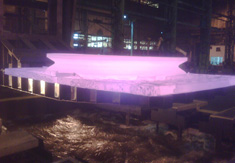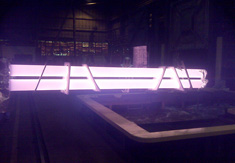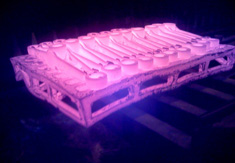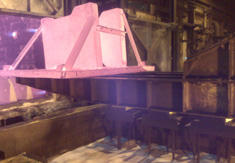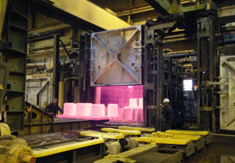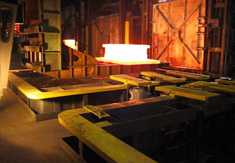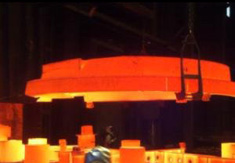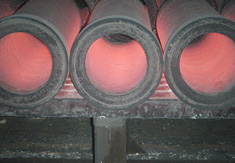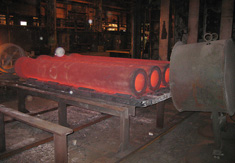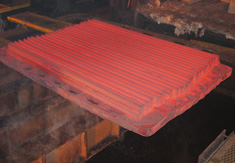Heat Treating Services

Our heat treating capabilities at Complete Heat treating encompass a wide variety of applications and part sizes. We offer stress relieving, annealing, quenching, tempering, and normalizing of fabrications up to 53′ long X 18′ wide X 15′ High and weighing up to 100,000 lbs. Open fire furnaces are available in multiple sizes and are capable of reaching up to 2100°F.
In addition to a large assortment of open fire furnaces, Complete Heat Treating now offers atmosphere heat treating including carburizing, carbonitriding, neutral atmosphere and flame hardening services. Below is a listing of some of the heat treating services we offer.
Please see the capabilities page for additional furnace specifications and capabilities.
Aging
Aging is a process typically applied to aluminum alloys, and nickel based alloys to improve strength and hardness. T-6 is a common age heat treat process (typically between 310-340°F) we apply to some aluminum alloys.
Higher temperature aging process at 1325-1400°F is applied to Nickel based alloys such as Inconel 718
Annealing
Annealing is typically done to make the alloy softer to help forming and machining. It is often applied to steels but can be used for other alloys. There are different type of annealing processes that we do namely:
- Full Annealing
This is often a very long cycle-time to not only soften steel but to ensure very low residual stress - Process Annealing
The process anneal is typically performed at a much lower temperature than the full anneal and the cycle time is much quicker. However, steel is not as soft nor is it in a very low stress state after the process anneal. - Sub-Critical Annealing
This is a common process applied to various cast irons to improve the cast microstructure, stress state of the casting and soften.
Carburizing
In 2021 Complete introduced an additional capability with a modernized integral quench gas carburizing furnace. Gas carburizing is a useful process to increase the carbon content at the outside of the component and then to allow much greater hardness at and near the surface and retain toughness at the core of a component.
Carbonitriding
In 2022, Complete added carbonitriding capability, which similar to carburizing allows increase of carbon (and nitrogen) to the surface and near surface of the component with even greater hardnesses typically achieveable compared to carburizing only (but with typically shallower depths of hardening)
Flame Hardening
Flame hardening is a process to locally heat the outside of the component and then to rapidly cool (quench) the heated section. This can be done by progressively heating a section of a part at a time followed by rapid cooling, or by heating an entire band uniformly and cooling all at once. Complete performs both processes
Hydrogen Baking
Hydrogen bake is a heating to a low temperature (about 400°F) for an extended time based on section size and other variables to remove or move hydrogen to improve ductility of steel. The process can take several hours or weeks but the ductility improvement can be substantial
Normalizing
This is a process of heating the part to completely change the atomic arrangement to improve properties such as strength, ductility hardness, or to improve the uniformity of the structure. Complete regularly performs this process to irons and steels
Precipitation Hardening
This is similar to aging however some stainless steels undergo this treatment such as 17-4 PH. If steels are supplied to Complete in the solution annealed condition, this process alone is done. However, if the stainless steel is not in the solution annealed condition (or there is reason to suspect the process was not properly performed) a 2 step of process is done.
Quenching and Tempering
The quench and temper process is actually a 3-step process and is performed daily at Complete. First of all the part is heated in the furnace to a temperature of typically a minimum of 1500°F-1700°F depending on the part’s chemistry. Then the part is rapidly immersed in a liquid of oil, water, salt water or water soluble polymer and held until the part has cooled down.
This process results in increased hardness and greater levels of residual stress, and so is always followed by a tempering process. Tempering is a process of re-heating to a temperature between 320-1350°F (depending on alloy content) to ensure that toughness is restored, residual stress is reduced and the proper hardness and strength achieved
Solution Annealing
Solution anneal is a process typically applied to stainless steels, heating to temperatures typically between 1925-2100°F then rapidly cooling. Other than some exceptions, the major benefit of this process is to optimize corrosion properties and often depending on the alloy content, there is no increase in strength. Complete regularly solution anneals stainless steels with quenching in water, or forced air.
Stress Relieving
All metal components have a certain amount of residual stress due to their prior processing (forging, casting, welding etc.), their prior heat treat, their prior microstructure and elemental interactions. Stress relieve is a process of heating to a temperature of about 1100°F (although many factors have influence on the actual temperature chosen which may be between 400-1300°F). After achieving the temperature, the part is typically held for some time then slow cooled before air cooling.
Please see the capabilities page for additional furnace specifications and capabilities.
Heat Treating Gallery:
